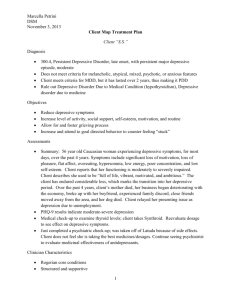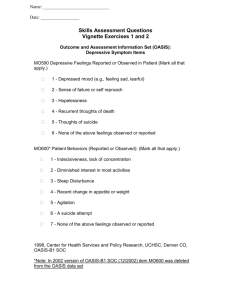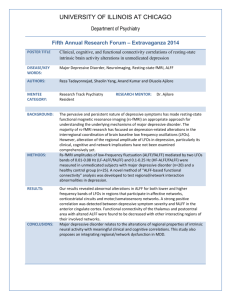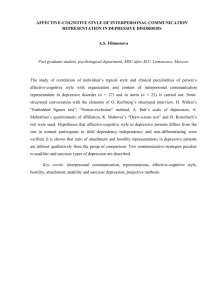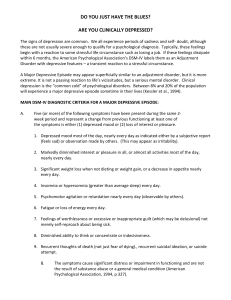Factors Associated with Depressive Symptomatology
advertisement
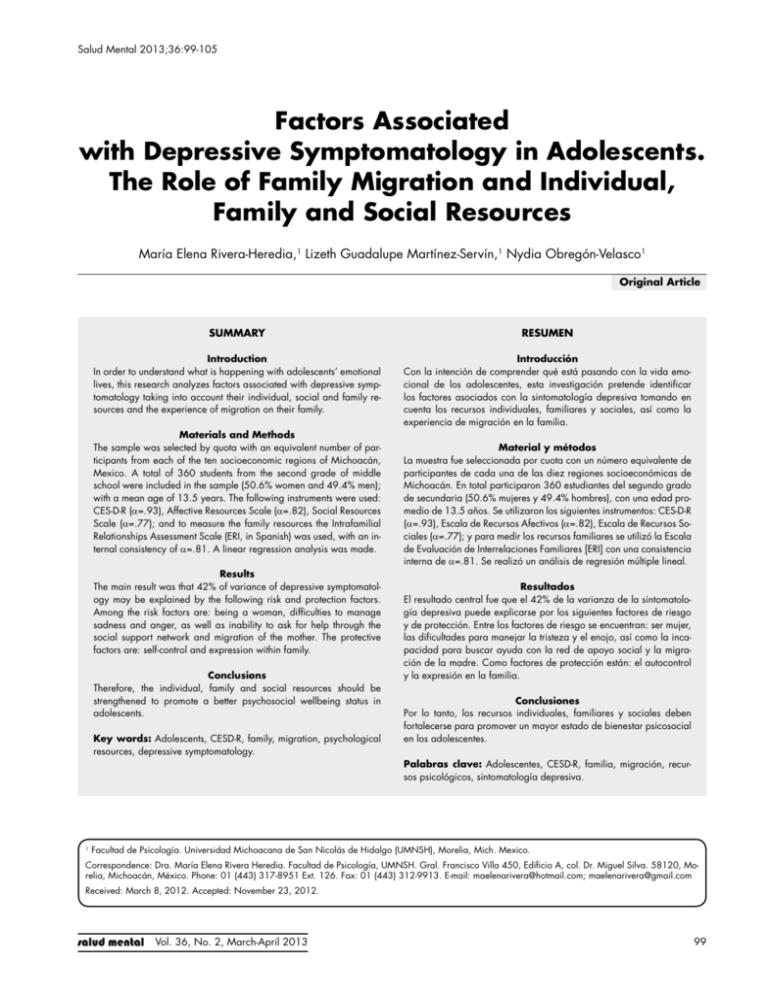
Salud Mental 2013;36:99-105 Depressive Symptomatology, Psychological Resources and Migration Factors Associated with Depressive Symptomatology in Adolescents. The Role of Family Migration and Individual, Family and Social Resources María Elena Rivera-Heredia,1 Lizeth Guadalupe Martínez-Servín,1 Nydia Obregón-Velasco1 Original Article SUMMARY RESUMEN Introduction In order to understand what is happening with adolescents’ emotional lives, this research analyzes factors associated with depressive symptomatology taking into account their individual, social and family resources and the experience of migration on their family. Introducción Con la intención de comprender qué está pasando con la vida emocional de los adolescentes, esta investigación pretende identificar los factores asociados con la sintomatología depresiva tomando en cuenta los recursos individuales, familiares y sociales, así como la experiencia de migración en la familia. Materials and Methods The sample was selected by quota with an equivalent number of participants from each of the ten socioeconomic regions of Michoacán, Mexico. A total of 360 students from the second grade of middle school were included in the sample (50.6% women and 49.4% men); with a mean age of 13.5 years. The following instruments were used: CES-D-R (α=.93), Affective Resources Scale (α=.82), Social Resources Scale (α=.77); and to measure the family resources the Intrafamilial Relationships Assessment Scale (ERI, in Spanish) was used, with an internal consistency of α=.81. A linear regression analysis was made. Results The main result was that 42% of variance of depressive symptomatology may be explained by the following risk and protection factors. Among the risk factors are: being a woman, difficulties to manage sadness and anger, as well as inability to ask for help through the social support network and migration of the mother. The protective factors are: self-control and expression within family. Conclusions Therefore, the individual, family and social resources should be strengthened to promote a better psychosocial wellbeing status in adolescents. Key words: Adolescents, CESD-R, family, migration, psychological resources, depressive symptomatology. Material y métodos La muestra fue seleccionada por cuota con un número equivalente de participantes de cada una de las diez regiones socioeconómicas de Michoacán. En total participaron 360 estudiantes del segundo grado de secundaria (50.6% mujeres y 49.4% hombres), con una edad promedio de 13.5 años. Se utilizaron los siguientes instrumentos: CES-D-R (α=.93), Escala de Recursos Afectivos (α=.82), Escala de Recursos Sociales (α=.77); y para medir los recursos familiares se utilizó la Escala de Evaluación de Interrelaciones Familiares [ERI] con una consistencia interna de α=.81. Se realizó un análisis de regresión múltiple lineal. Resultados El resultado central fue que el 42% de la varianza de la sintomatología depresiva puede explicarse por los siguientes factores de riesgo y de protección. Entre los factores de riesgo se encuentran: ser mujer, las dificultades para manejar la tristeza y el enojo, así como la incapacidad para buscar ayuda con la red de apoyo social y la migración de la madre. Como factores de protección están: el autocontrol y la expresión en la familia. Conclusiones Por lo tanto, los recursos individuales, familiares y sociales deben fortalecerse para promover un mayor estado de bienestar psicosocial en los adolescentes. Palabras clave: Adolescentes, CESD-R, familia, migración, recursos psicológicos, sintomatología depresiva. 1 Facultad de Psicología. Universidad Michoacana de San Nicolás de Hidalgo (UMNSH), Morelia, Mich. Mexico. Correspondence: Dra. María Elena Rivera Heredia. Facultad de Psicología, UMNSH. Gral. Francisco Villa 450, Edificio A, col. Dr. Miguel Silva. 58120, Morelia, Michoacán, México. Phone: 01 (443) 317-8951 Ext. 126. Fax: 01 (443) 312-9913. E-mail: maelenarivera@hotmail.com; maelenarivera@gmail.com Received: March 8, 2012. Accepted: November 23, 2012. Vol. 36, No. 2, March-April 2013 99 Rivera-Heredia et al. INTRODUCtioN According to the World Health Organization1 approximately 121 million people worldwide suffer from depression, which is a mood chronicle or recurring disorder affecting the skill to face everyday life and one of the major causes of work disability. The main symptoms of depression are sadness, loss of pleasure, feelings of guilt and of low self-worth, changes in sleep and appetite, decrease in energy and concentration; it is associated with suicides, homicides, aggressive behaviors and use of drugs.2 Although the importance of depression is recognized as a mental health problem worldwide and in Mexico, it is necessary to intensify efforts so that the population may be served timely.3 Also, it is necessary to work in the design of public policies that may increase availability and access of mental health services aimed at adolescents.4 For early and timely detection of depression risk factors there are screening instruments that assess depressive symptomatology. One of the most recognized internationally instruments is the Center for Epidemiological Studies Depression Scale (CES-D)5 as well as its the revised version (CESD-R).6,7 Even though depression is present in different life stages,810 one of the higher-risk periods for its appearance is adolescence, due to the vulnerability of this stage,11 besides the chronicity risk of such illness when it begins at early ages, since over 3% of adolescents suffer from depressive conditions so severe that they may cause several social dysfunctions.12 Depressive symptomatology in adolescents has unique characteristics such as more acute symptoms of helplessness, lack of pleasure, desperation and weight changes more severe than in adults. Detected depressive episodes combine malfunctioning periods with stages of proper functioning, being more likely the substance abuse, unintended pregnancy and violent behaviors, especially against themselves, i.e. suicide attempts.13 During adolescence there has been found an association among depressive symptomatology with dropping out, la restrictive excitement,14 as well as with several mental health problems.15,16 Studies conducted in Mexico reported a higher depressive symptomatology within a difficult family environment, involving a hostile and rejecting communication, as well as little family cohesion.17 On the contrary, the aspects that promote a positive emotional adjustment in adolescents and, thus, minimize the risk of the existence of a depressive disorder involve the presence of an open and fluid communication between parents and children, the expression of positive emotions, the existing union and support within family or a clear organization of the parents towards the children regarding the discipline rules.18-21 In one of the few studies conducted in Mexico tackled by the psychological resources and the depressive symptomatology it was found that youths with suicide attempt have a minor development of their affective, cognitive, so- 100 cial (difficulty in seeking support) and family (less union and family support, less expression within family and more perception of family difficulties) resources, than adolescents without suicide attempt.22 Psychological resources are defined as objects, conditions, personal characteristics and intangible elements that —for themselves— have a survival value, either directly or indirectly, and serve as a means to reach new resources. The resources may be preserved, obtained, protected, promoted and exchanged.23 The theory of resources preservation24,25 explains stress based on how persons obtain, preserve, develop and protect their resources, trying to adapt and fit in the contexts in which they are, so that they use the resources for regulating themselves and the social relationships they establish. Resources exist in “caravans”, that is, they are not developed in isolation but in group and under a special context sensitivity, hence for understanding what happens with adolescents when they face stressful circumstances, what happens to their psychological resources and what occurs with the presence or lack of presence of the depressive symptomatology, it is necessary to understand the individual behavior within the context, for which an ecological and multifactorial perspective is required. Stated briefly, an adolescent who is suffering mental health problems should be early detected since this requires timely support allowing him/her to live this stage without too much trouble. Currently, results are available from different researches on depressive symptomatology in Mexican adolescents. Nevertheless, there are still no sufficient studies emphasizing the role of psychological resources —both individual and family resources—, or the relationship of depressive symptomatology with several stressful events such as family migration.26,27 Likewise, there is a lack of researches reporting the use of the new revised version of the CESD-R.28 The relevance of this paper is focused on these elements. The purpose of this research was identifying the factors associated with depressive symptomatology of adolescents from Michoacán from their individual psychological (selfcontrol, balance recovery, management of sadness and anger), social (social support network and ability to ask for help to such network) and family (union and support, expression and family problems) resources, considering family migration. MATERIALS AND METHODS Participants Overall, 360 students participated with an average age of 13.6 years (SD=.67), 49.4% were men and 50.6%, women; minimum age was 12 years old and maximum 16. Participants were studying second grade at a public secondary school from each of the ten socioeconomic regions of the State of Michoacán, Mexico, which towns and number of Vol. 36, No. 2, March-April 2013 Depressive Symptomatology, Psychological Resources and Migration participants were: Lerma Chapala with Zamora (50); Bajío with Zacapu (42); Cuitzeo with the City of Morelia (48); Oriente with Ciudad Hidalgo (34); Tepalcatepec with Apatzingán (34); Purépecha with Uruapan (20); Pátzcuaro-Zirahuén with Pátzcuaro (27); Tierra caliente with Huetamo (50); Sierra Costa with Lázaro Cárdenas (34) and Infiernillo with Ario de Rosales (21). It was a non-probabilistic sample. 34.4% stated having a migrant father, 13.1% a migrant mother and 17.2% had at least a migrant brother or sister. Instruments Two psychological resources scales developed and validated by Rivera-Heredia y Andrade were taken up:22 the Affective Resources Scale (α=.82), which was considered to assess the individual resources, and the Social Resources Scale (α=.77). In order to assess the family resources the Intrafamilial Relationships Assessment Scale (ERI, in Spanish) in its twelve-question short version was used (α=.91). The depressive symptomatology was assessed with the revised version of the Center for Epidemiological Studies Depression Scale (CESD-R) with 35 questions, which was developed by Radloff,5 validated in Mexico by Mariño, Medina-Mora, Chaparro and GonzálezForteza.29 Such revised version (CESD-R) has shown being valid and reliable in adolescent students6 and in the elderly.7 In order to maintain appropriate levels of internal consistency it was necessary to remove some questions, such as the 24th from the dysphoria subscale; the 10th from the anhedonia subscale; and the 22nd from the excessive guilt subscale. Those subscales that had less than two questions were not included in this research, such as fatigue, appetite, psychomotor retardation and thought. The suicidal ideation subscale was adjusted with questions 14 and 15 of the CESD-R together with three additional questions that have been reconsidered in other researches on this topic.28,30 The total CESD-R scale was made up by 35 questions. Procedure Permission was requested to the Secretariat of Public Education of Michoacán for having access to the schools. Once having this approval the principals of ten middle schools were contacted. Previously trained psychologists applied the instruments to the students in their classrooms. Students were invited to participate voluntarily. The confidentiality of the handling of data provided by the students was emphasized. Such psychologists traveled from the City of Morelia to the municipalities corresponding to each participating region. The management of the instruments was carried out quietly and with no incidents from April through June, 2010. Data Analysis Multiple regression analyses were conducted using the successive step method, as well as Pearson’s correlation and average-to-average analyses. The SPSS 17.0 statistics software suite was used.31 RESULTS The internal consistencies of the scales and subscales of the CESD-R and the Individual, Social and Family Resources Scales, obtained from the sample that participated in this study are shown in Table 1, which are accompanied by an example of a question of each subscale. Table 1. Reliability and examples of questions from the subscales of CESD-R and of the individual, social and family resources Subscales and Examples of Questions Cronbach ‘s Alpha Depressive Symptomatology (total questions of CESD-R) 1. Depressed mood (dysphoria) I could not stop being sad 2. Decrease of pleasure (anhedonia) Nothing made me happy 3. Excessive or inappropriate guilt I thought my life have been a failure 4. Social isolation (friends/occupation/family) I talked less than usual 5. Suicidal ideation I wished I was dead .91 .84 .65 .77 .69 .91 Individual Resources (total questions of Affective Resources) 7. Self-control I can face difficult situations remaining calm 8. Balance recovery Being aware of how I feel helps me overcoming my problems 9. Difficulties to manage sadness When I am very sad I feel that my problems cannot be solved 10. Difficulties to manage anger I lose control when I get angry .82 .74 .61 .73 .48 Social Resources (total questions of Affective Resources) 11. Support network At least I have one person who listens to me 12. Difficulties to ask for help I find it very difficult to ask others for help .77 .71 .68 Family Resources (total questions of Family Resources) 13. Union and support Usually, my family does things together 14. Expression My parents encourage me to openly express my points of view 15. Difficulties Nobody in my family is concerned for others’ feelings .81 .83 .84 .59 Vol. 36, No. 2, March-April 2013 101 Rivera-Heredia et al. Table 2. Explanation of depressive symptomatology through individual, family and social resources, as well as of family migration using the multiple regression analysis Statistics of change Model R 1. 2. 3. 4. 5. 6. 7. .55a .61b .62c .64d .64e .65f .66g R squared R squared corrected Typical error Change in R squared Change in F .31 .37 .39 .41 .42 .43 .44 .30 .37 .39 .41 .41 .42 .43 19.98 19.01 18.70 18.44 18.33 18.22 18.11 .31 .07 .02 .02 .01 .01 .01 150.52 36.53 12.63 10.47 5.38 4.95 5.18 Degrees of freedom Beta 1343 1342 1341 1340 1339 1338 1337 .347 -.224 -.146 .151 .122 .103 .093 Next change in F DurbinWatson .000 .000 .000 .001 .021 .027 .023 1.930 a.Predicted variables:(Constant), difficulties to manage sadness b Predicted variables:(Constant), difficulties to manage sadness, self-control c.Predicted variables:(Constant), difficulties to manage sadness, self-control, expression d.Predicted variables:(Constant), difficulties to manage sadness, self-control, expression, difficulties to manage anger e.Predicted variables:(Constant), difficulties to manage sadness, self-control, expression, difficulties to manage anger, inability to ask for help f.Predicted variables:(Constant), difficulties to manage sadness, self-control, expression, difficulties to manage anger, inability to ask for help, gender g.Predicted variables:(Constant), difficulties to manage sadness, self-control, expression, difficulties to manage anger, inability to ask for help, gender, migrant mother h.Dependent variable : Total score of CESD-R with 35 questions. 102 have direct migrant family members have higher depressive symptomatology scores than those who do not have the migrant family experience. Such differences are statistically significant in the case of dysphoria (=0.72 y =1.05, t=-2.736, gl=114.5, p=.01), isolation (=0.69 y =0.96, t=-2.18, gl=105.8, p=.041) and suicidal ideation ( =0.41 y =0.70, t=-2.065, gl=116.451, p= .040). There are statistically significant differences by gender in four of the five subscales of depressive symptomatology. In all cases women have higher depressive symptomatology scores than men (Table 4). Likewise, women have greater difficulties in the management of sadness and anger. In contrast, women have significantly higher scores of support network than men. In the subscales of anhedonia and in the affective resources of self-control, management of sadness, in the social resources of difficulties to ask for help and in the three scales of family resources, both men and women have similar scores. Suicidal ideation Isolation Dimensions In order to determine the factors associated with the depressive symptomatology the research was aimed at identifying the variables that predict the depressive symptomatology of Michoacán adolescents. Through the multiple regression analyses with the successive step method it was found an explanation of 43% of the variance with the participation of seven variables. The most significant was the variable of difficulties in the management of sadness, followed by self-control, expression within family, difficulties in the management of anger, difficulties for seeking help, the gender of the student and having a migrant mother. In these results there are individual, family and social resources, apart from variables contemplating family migration (Table 2). As shown in Table 3, and being consistent with the theoretical construct of the instrument, the depressive symptomatology scales present correlations that are statistically significant among them, with a positive direction and average and high values. Regarding the psychological resources, in the case of self-control it is correlated significantly in a negative and low way with all the CESD-R subscales. On the contrary, the subscales of difficulties for the management of sadness and anger are correlated positively with the CESD-R subscales. The dimensions of difficulties within family, support network and balance recovery did not present significant correlations with the depressive symptomatology subscales. From the 360 participants, 164 (45.6%) had a direct migrant relative: the father, the mother or a brother or sister; the migration of indirect or extended family relatives such as cousins, uncles, nephews, brothers-in-law, was presented by 142 participants (39.4%). Only 54 (15%) students reported not having migrant family members. Figure 1 shows that in the five assessed depressive symptomatology scales, those who Guilt Anhedonia Dysphoria Total CESD-R .00 .20 .40 Migration of immediate family .60 .80 1.00 1.20 1.40 No family migration Figure 1. Comparison of average scores in depressive symptomatology scales of the CESD-R according to family migration. Vol. 36, No. 2, March-April 2013 1 1 -.33** -.19** -.30** .27** .30** .33** -.22** -.03 -.04 .00 -.16** -.20** .08 .19** .17** -.16** .20** .19** -.17** -.25** -.28** .17** -.25** -.25** .18** -.22** -.26** .20** -.32** -.32** .23** -.28** -.30** .18** Family Resources 13.Family union and support 14.Expression within the family 15.Difficulties within the family Vol. 36, No. 2, March-April 2013 * p≤ .05, ** p≤ .01. 1 1 -.10 .17** .21** -.12* .38** Social Resources 11.Support network 12.Difficulties to ask for help -.11 .35** -.27** .25** -.15** .34** -.03 .35** -.11* .28** .39** -.09 .35** .06 .13* .45** 1 1 .47** 1 .11* .13* 1 .48** -.07 .02 -.25** -.09 .43** .29** -.19** -.01 .41** .28** -.25** -.11* .44** .31** -.33** -.25** .30** .11* -.29** -.09 .55** .36** Individual Resources 7.Self-control 8.Balance recovery 9.Difficulties to manage sadness 10.Difficulties to manage anger -.26** -.07 .56** .36** 1 1 .56** 1 .63** .67** 1 .44** .23** .41** 1 .52** .73** .68** .71** .91** .54** .83** .78** .80** Depressive Symptomatology 1.Total CESD-R 2.Depressed mood (dysphoria) 3.Decrease of pleasure (anhedonia) 4.Excessive or inappropriate guilt 5.Social isolation (friends/occupation/family) 6.Suicidal ideation -.22** -.25** .12* 13 12 11 10 9 8 7 6 5 4 3 2 1 1 Table 3. Pearson product-moment correlation of the subscales scores of depressive symptomatology, and individual, family and social resources DISCUSsioN 1 .79** -.29** 15 14 Depressive Symptomatology, Psychological Resources and Migration Given the complexity and multifactoriality of depression and its associated symptomatology, there is still a lack of many elements in order to achieve a comprehensive explanation of same. However, studies like this one contribute to clarify the participation of some variables in the depressive symptomatology as is the case of 43% of the variance explained through individual, social and family resources and the sociodemographic variables of gender and presence of family migration, thus these variables may be considered either as risk or protection factors. The main limitation of this study is that the sample, although gathered in the ten socioeconomic regions of the State of Michoacán, was not representative, hence it is not possible to make sweeping statements or generalizations based on the results found. As for the measuring instruments, another limitation was the low reliability of the subscales of difficulties for management of sadness and family difficulties, which in previous researches had appeared with higher scores.23 It could be associated with topics that may cause confusion in adolescents or that may have implicit elements of social desirability bias. Since both scales have few questions it is proposed that in future applications new supporting questions are included. The fact of “being a woman” resulted a risk factor associated with the depressive symptomatology of adolescents. This should not be considered as a definitive result because the possibility that the CES-D and CESD-R Scales present any difference due to the gender has been reiteratively stated; given that in general women have higher scores than men, while it is likely that this only measures female attitudes expected by culture.32 The same happens with other diagnostic instruments about this construct, a fact that leads one to think on both the nosology of depression and on the form it has been measured. Another risk factor observed in this sample of adolescents was “having a migrant mother”, which produces interesting data that give supporting elements to focus on the relatives that stay rather than on the migrants themselves. For example, previous studies detected that there is more depression in migrant persons than in non-migrant persons.33 However, a deeper research is still needed allowing to know what happens with those who stay for living and working in their country but have migrant relatives. On the other hand, considering that for many years the Mexican migratory tradition was of men, an effect of “adaptation” to the “uses and customs” of the family or region could occur due to the father’s migration. Nevertheless, it is different when the mother emigrates; according to the results of this paper the migration of the mother is closely related to the depressive symptomatology of participating students. 103 Rivera-Heredia et al. Table 4. Dimensions of depressive symptomatology and individual and social resources where significant differences by gender were found. Gender Mean SD t gl Signif. Depressive Symptomatology Dysphoria Women Men 1.23 0.68 0.95 0.59 6.62 358 .001 Guilt Women Men 0.84 0.5 0.99 0.68 3.76 358 .001 Isolation Women Men 1.03 0.7 0.92 0.74 3.79 358 .001 Suicidal ideation Women Men 0.9 0.3 1.23 0.56 5.92 358 .001 Individual (Affective) Resources Difficulties to manage sadness Women Men 2.45 1.92 0.76 0.66 7.01 356 .001 Difficulties to manage anger Women Men 2.52 2.32 0.51 0.49 3.77 356 .001 Social Resources Support network Women Men 3.1 2.75 0.81 0.82 4.09 357 .001 Until not having further empirical evidence the explanations on depression in migrants provided by Bhugra26 could be reconsidered as working hypotheses applied in adolescents of the studied sample who have a migrant mother, such as feeling of loss, fatalism, experience of negative life events, lower development of social skills, contradictions in the systems of beliefs and values, among others, which adolescents could be experiencing after staying in their communities of origin and being exposed to the influences caused by a migration from such a significant person in the Mexican family dynamics; like the mother figure has traditionally been. This is a topic suggested to be considered in subsequent studies. On the other hand, in scientific literature has been found that the greater stress and the lesser social support, the greater depression.25 This study emphasizes that rather than not having a support network what happens to adolescents with depressive symptomatology is that they have difficulties to request support to their network, which coincides with previous researches.22 Such difficulties may relate to the “restrictive excitement” (difficulty a means to express one’s feelings and emotions) existing in adolescents with symptoms of depression and suicide attempt,14 and that is detected in the adolescents of this study, who also report difficulties with management of sadness and anger. It was found that a protective factor in the presence of the depressive symptomatology was the “expression within the family”, which implies the possibility to communicate feelings and emotions within a context of acceptance and respect by the family members. This result is the counterpart of some family factors that have been previously identified as risk factors in the presence of depression such as the dif- 104 ficult family dynamics, characterized by an aggressive or rejecting communication, parental money conflicts, excess or lack of parental control and scarce family cohesion.6,18-20 It is necessary to reinforce the fact of having an ecological vision to focus greater attention on the environments in which the individuals get by in order to better understand depressive symptomatology, stressful events, as well as the resources they face this and thrive. As proposed by Hobfoll24 it is possible to promote the development of the “resources in caravans” being necessary to identify how they obtain, preserve, increase, protect or lose the resources they have, to the extent they become adjusted to their different contexts. Thus, we propose the design of researches that analyze what occurs in adolescents within real contexts in which they get by, incorporating strategies of direct observation. Additionally, it bears mention to include the cultural differences and be able to work in a targeted way by region, in order to obtain an intervention designed for the necessities of each municipality; interventions that start from the identification, preservation, promotion and obtaining of psychological resources. Results of this research may be reconsidered for the development of intervention proposals specific for the population with higher risk (for instance, programs for women, or for youth with direct family migration, especially regarding the mother), besides reinforcing protective factors in adolescents. A core recommendation is to work with the affective resources of adolescents, developing a better skill for the management of sadness and anger as well as a better selfcontrol. As for social resources they should be supported in the development of skills to ask for help at their support network and, as for family resources, it is recommended Vol. 36, No. 2, March-April 2013 Depressive Symptomatology, Psychological Resources and Migration to promote the expression of emotions and feelings within the family from an acceptance and respect position of its members. Continuing this work is a task to be performed by health care providers, social sciences, educators, parents and researchers. ACKNOWLEDGEMENTS We wish to thank the support given by the Secretariat of Public Education through the enhancement teaching program and research project: “Promotion of Health and Prevention of problem behaviors in middle school students” PROMEP-UMSNH-252. We also wish to thank the Secretariat of Public Education of the State of Michoacán that facilitates access to middle schools. Additionally, we would like to thank graduates of Facultad de Psicología (School of Psychology), Universidad Michoacana de San Nicolás de Hidalgo, who collaborated in this project: Diana Paulina Escutia, Héctor Hurtado, Patricia Rodríguez, Ángeles Durán, Criceida Pedro, Olivia Zamora, Laura Hernández Alegre, Monserrat García, Zeila Chávez, Brenda Corona, Ligia Velázquez, Lizbeth Sánchez, Margarita Vega, Miriam Roxana Mora and Maricarmen Gómez. REFERENCeS 1. World Health Organization (WHO). Mental Health. Depression. Available at: http://www.who.int/mental_health/management/depression/ definition/en. Access date: August 29, 2011. 2. Pardo G, Sandoval A, Umbarila D. Adolescencia y depresión. Rev Col Psicol 2004;13:17-42. 3. Wagner FA, Gallo JJ, Delva J. Depression in late life: A hidden public health for Mexico? Salud Publica Mex 1999;41:189-202. 4. Benjet C, Borges G, Medina-Mora ME, Zambrano J et al. Youth mental health in a populous city of the developing world: Results from the Mexican Adolescent Mental Health Survey. J Child Psychol Psychiatry 2009;50(4):386-395. 5. Radloff LS. Scale: A self-report depression scale for research in the general population (CES-D). Appl Psychol Meas 1977;1:385-401. 6. González-Forteza C, Jiménez-Tapia JA, Ramos-Lira L, Wagner FA. Aplicación de la Escala de Depresión del Center of Epidemiological Studies en adolescentes de la Ciudad de México. Salud Publica Mex 2008;50(4):292-299. 7. Reyes M, Soto AL, Milla JG, García A Et al. Actualización de la Escala de Depresión del Centro de Estudios Epidemiológicos (CES-D) en Poblaciones Geriátricas Mexicanas. Un estudio piloto. Salud Mental 2003;26(1):59-68. 8. García-Peña C, Wagner FA, Sánchez-García S, Juárez-Cedillo T et al. A study of depressive symptoms among older adults in Mexico City. JGIM 2008;23:1973-1980. 9. Van Dam NT, Earleywine M. Validation of the Center for Epidemiologic Studies Depression Scale-Revised (CESD-R): Pragmatic depression assessment in the general population. Psychiatry Res 2011;186(1):128-132. 10. Chabrol H, Rodgers R, Rousseau A. Relations between suicidal ideation and dimensions of depressive symptoms in high-school students. J Adolesc 2007;30:587-600. 11. Andrade P, Betancourt D. Factores individuales, familiares y sociales y conductas de riesgo en adolescentes. En: Andrade P, Betancourt D, Cañas JL (eds.). Investigaciones psicosociales en adolescentes. México: Colección Montebello, UNICACH y UNAM; 2008. 12. Harrington R. Consecuencias psicosociales de la depresión adolescente. Psiquiatría Salud Integral 2001;1(2):48-52. Vol. 36, No. 2, March-April 2013 13. Vallejo A, Osorno R, Mazadiego T. Sintomatología depresiva medida con las CES-D en adolescentes del norte de Veracruz. En: Andrade P, Betancourt D, Cañas JL (eds.). Investigaciones psicosociales en adolescentes. México: Colección Montebello, UNICACH y UNAM; 2008. 14. Jacobson CM, Marrocco F, Kleinman M, Gould MS. Restrictive emotionality, depressive symptoms, and suicidal thoughts and behaviors among high school students. J Youth Adolescence 2011;40:656–665. 15. Ruelas E, Lozano R. ¿Juventud saludable? Este país. Tendencias Opiniones 2009;217:55-59. 16. Bagur AR. La atención de los jóvenes mexicanos. ¿Éxito o fracaso? Este país. Tendencias Opiniones 2009;217:4-14. 17. Álvarez-Zúñiga M, Ramírez-Jacobo B, Silva-Rodríguez A, Coffin-Cabrera N et al. La relación entre depresión y conflictos familiares en adolescentes. International J Child Psychol Psychiatry 2009;9(02):205-216. 18. Galicia-Moyeda IX, Sánchez-Velasco A, Robles-Ojeda FJ. Factores asociados a la depresión en adolescentes: Rendimiento escolar y dinámica familiar. Anales Psicología 25(2):227-240. 19. Estévez E, Musitu G, Herrero J The influence of violent behavior and victimization at school on psychological distress: the role of parents and teachers. Adolescence 2005;40:183-195. 20. Monge-Holguín JA, Cubillas-Rodríguez MJ, Román-Pérez R, AbrilValdez E. Intentos de suicidio en adolescentes de educación media y superior y su relación con la familia. Psicología Salud 2007;17:45-51. 21. Rivera-Heredia, ME. Psicología y comunicación visual. Estrategias para la prevención del suicidio en adolescentes. México: Trillas; 2010. 22. Rivera-Heredia ME, Andrade P. Recursos individuales y familiares que protegen al adolescente del intento suicida. Rev Intercont Psicol Educ 2006;8(2):23-40. 23. Alvaro C, Lyons RF, Warner G, Hobfoll SE et al. Conservation of resources theory and research use in health systems. Implementation Science 2010;5(79):1-20. 24. Hobfoll SE. Conservation of resource caravans and engaged settings. J Occup Organ Psychol 2011;84:116-122. 25. Vranceanu AM, Hobfoll H, Johnson R. Child multi-type maltreatment and associated depression and PTSD symptoms: The role of social support and stress. Child Abuse Negl 2007;31:71-84. 26. Bhugra D. Migration and depression. Acta Psychiatr Scand 2003;108(Suppl. 418):67-72. 27. Aguilera-Guzmán RM, Carreño-García MS, Juárez-García F. Características psicométricas de la CES-D en una muestra de adolescentes rurales mexicanos en zonas con alta tradición migratoria. Salud Publica Mex 2004;27(6):57-66. 28. González-Forteza C, Ramos-Lira L, Caballero-Gutiérrez MA, Wagner FA. Correlatos psicosociales de depresión, ideación e intento suicida en adolescentes mexicanos. Psicothema 2003; 15(4):524-532. 29. Mariño C, Medina-Mora ME, Chaparro A, González-Forteza C. Confiabilidad Y estructura factorial del CES-D en la muestra de adolescentes mexicanos. Rev Mex Psicol 1993;2:141-145. 30. Roberts E. Reliability of the CES-D: Scale in different ethnic contexts. Psychiatry Res 1980;2:125-134. 31. SPSS para Windows Versión 17.0. Illinois: SPSS INC. 2007. 32. Osorno-Munguía JR, Vallejo-Casarín A, Segura Celis-Ochoa B, Mazadiego-Infante TJ. Evaluación del funcionamiento diferencial de los ítems (DIF) de la Escala de Depresión del Centro para Estudios Epidemiológicos (CES-D) respecto del género en una muestra de adolescentes mexicanos. Rev Electr Psicol Iztacala 2008;11(2):138-152. 33. Borges G, Breslau J, Maxwell Su, Miller M et al. Immigration and Suicidal Behavior Among Mexicans and Mexican Americans. Am J Public Health 2009;99(4):728-733. Declaration of conflict interest: None 105
